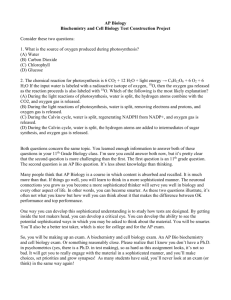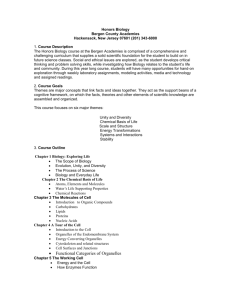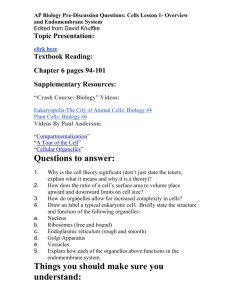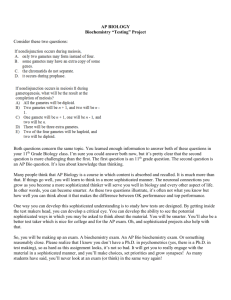Biochemistry and Cell Biology Test Construction
advertisement
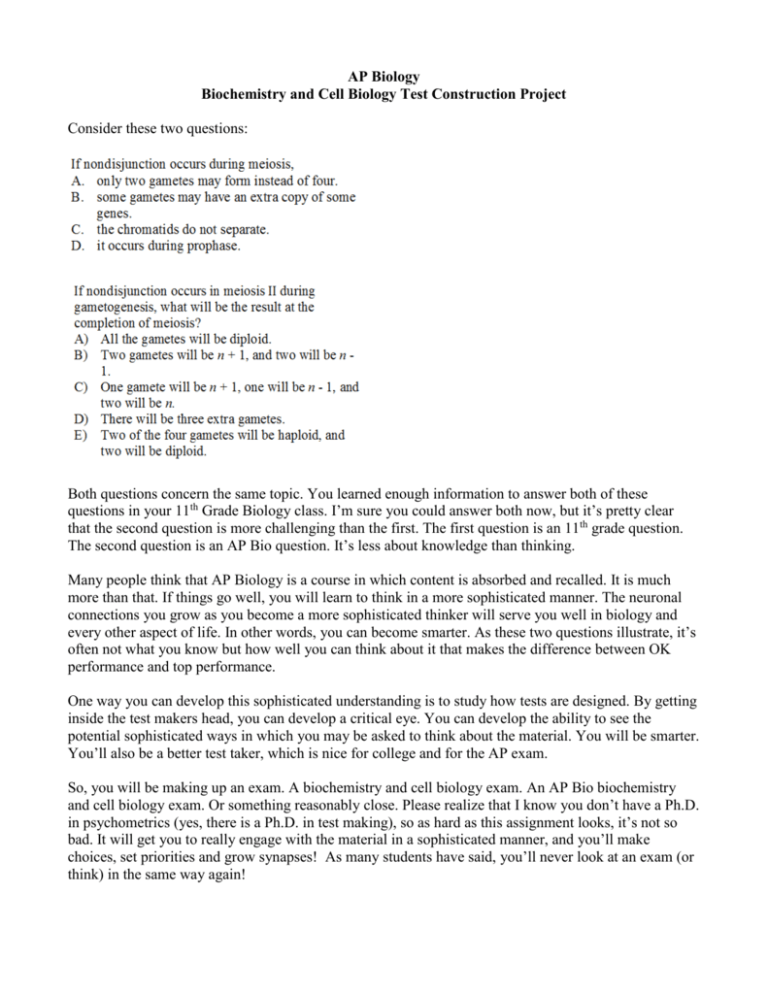
AP Biology Biochemistry and Cell Biology Test Construction Project Consider these two questions: Both questions concern the same topic. You learned enough information to answer both of these questions in your 11th Grade Biology class. I’m sure you could answer both now, but it’s pretty clear that the second question is more challenging than the first. The first question is an 11th grade question. The second question is an AP Bio question. It’s less about knowledge than thinking. Many people think that AP Biology is a course in which content is absorbed and recalled. It is much more than that. If things go well, you will learn to think in a more sophisticated manner. The neuronal connections you grow as you become a more sophisticated thinker will serve you well in biology and every other aspect of life. In other words, you can become smarter. As these two questions illustrate, it’s often not what you know but how well you can think about it that makes the difference between OK performance and top performance. One way you can develop this sophisticated understanding is to study how tests are designed. By getting inside the test makers head, you can develop a critical eye. You can develop the ability to see the potential sophisticated ways in which you may be asked to think about the material. You will be smarter. You’ll also be a better test taker, which is nice for college and for the AP exam. So, you will be making up an exam. A biochemistry and cell biology exam. An AP Bio biochemistry and cell biology exam. Or something reasonably close. Please realize that I know you don’t have a Ph.D. in psychometrics (yes, there is a Ph.D. in test making), so as hard as this assignment looks, it’s not so bad. It will get you to really engage with the material in a sophisticated manner, and you’ll make choices, set priorities and grow synapses! As many students have said, you’ll never look at an exam (or think) in the same way again! Introduction to the Project The AP Biology curriculum contains many objectives relating to biochemistry and cell biology. You have really learned all this content last year in your biology class. However, you did not necessarily think about the content in the ways that the AP folks require, though you may have come pretty close. This unit is one you will do on your own. Your task is simple yet challenging. It will also change the way you look at learning and testing. Below you will find a list of AP objectives (LOs) that you will need to able to do for the AP Bio exam. Your task is to create an AP style exam that includes at least one question for each LO. Making up a test is challenging. The test maker must pay attention to both the skills students must demonstrate as well as the content that has been covered. We have listed a general objective with some key concepts and then the actual AP objectives. Your questions should correspond to the objectives but be about the concepts. Remember, you are trying to demonstrate your sophisticated understanding of the material and skills to your teacher. Each question (or groups of questions) should relate to a diagram (what the AP folks like to call representations and models), data tables, graphs, or narratives. In other words, the test taker should be able to rely on the test for the information needed with little emphasis on memorization. In other words, stay away from labeling cells. You will need to design at least 30 questions. At least 15 of these must be multiple choice. At least 10 of these should be short answer (a few sentences). At least one question must involve a calculation. Some LOs will lend themselves to a single question (such as the first 3), others will work best with question sets (such as the last 3) Plan on having some groups of questions relating to same narrative or diagram. Pay close attention to the words in boldface in each LO. These words will help you decide what kind of question to use and what kid of narrative or diagram is needed. You must provide an answer key. You will find resources such as pictures from the book and information about test construction below. You can find elaboration about each LO by reading the AP Bio Curriculum. AP Bio Big Ideas BIG IDEA 1: The process of evolution drives the diversity and unity of life. BIG IDEA 2: Biological systems utilize energy and molecular building blocks to grow, to reproduce, and to maintain homeostasis. BIG IDEA 3: Living systems store, retrieve, transmit, and respond to information essential to life processes. BIG IDEA 4: Biological systems interact, and these interactions possess complex properties. Essential Questions How does the structure of molecules enable their functions? How does the structure of cells and organelles enable their functions? How do molecules and organelles interact to enable cells to functions? Reading: Hillis, chapters 2, 3, 4, 6 Learning Objectives (this is what the test covers): 1. Relate cell size and shape to the ability of cells to transport materials Key concepts: Surface area to volume ratio Structure of cell membrane Types of molecules that are nutrients and wastes LO 2.6 The student is able to use calculated surface area-to-volume ratios to predict which cell(s) might eliminate wastes or procure nutrients faster by diffusion. LO 2.7 Students will be able to explain how cell size and shape affect the overall rate of nutrient intake and the rate of waste elimination. LO 2.8 The student is able to justify the selection of data regarding the types of molecules that an animal, plant or bacterium will take up as necessary building blocks and excrete as waste products. 2A. Relate the structure of cell organelles to their function. 2B. Explain, using examples and diagrams, how cell organelles interact. 2C. Compare and contrast the structures and functions of eukaryotic and prokaryotic cells. Key concepts: Structure and functions of each organelle Cytoskeleton, flagella and cilia structure and function Prokaryotic vs. Eukaryotic cells Plant vs. Animal cells LO 2.13 The student is able to explain how internal membranes and organelles contribute to cell functions. LO 2.14 The student is able to use representations and models to describe differences in prokaryotic and eukaryotic cells. LO 4.4 The student is able to make a prediction about the interactions of subcellular organelles. LO 4.5 The student is able to construct explanations based on scientific evidence as to how interactions of subcellular structures provide essential functions. LO 4.6 The student is able to use representations and models to analyze situations qualitatively to describe how interactions of subcellular structures, which possess specialized functions, provide essential functions. LO 4.17 The student is able to analyze data to identify how molecular interactions affect structure and function. 3A. Relate the structures of the major biochemical groups to their functions. 3B. Relate the structure of enzymes to their functions. Key concepts: Monomers and polymers Lipid, protein and carbohydrate structure and functions Enzymes (structure, function, role of conditions, cofactors and coenzymes) LO 4.1 The student is able to explain the connection between the sequence and the subcomponents of a biological polymer and its properties. LO 4.2 The student is able to refine representations and models to explain how the subcomponents of a biological polymer and their sequence determine the properties of that polymer. LO 4.3 The student is able to use models to predict and justify that changes in the subcomponents of a biological polymer affect the functionality of the molecule. LO 4.17 The student is able to analyze data to identify how molecular interactions affect structure and function. 4A. Explain how energy is transferred between the processes of photosynthesis and respiration. 4B. Explain how energy is transferred within the process of photosynthesis. 4C. Explain how energy is transferred within the process of cell respiration. Key Concepts: Relationship between cell respiration and photosynthesis Electron Acceptor, Electron Donator Photosynthesis: light dependent and light independent reactions, role of chlorophyll Cell respiration: Glycolysis, Kreb's cycle, Electron Transport Chain (focus on what goes in and what comes out of each, not detailed steps) Fermentation Oxidation and reduction Role of NAD+/NADH, NADP+/NADPH, ADP/ATP LO 2.4 The student is able to use representations to pose scientific questions about what mechanisms and structural features allow organisms to capture, store and use free energy. LO 2.5 The student is able to construct explanations of the mechanisms and structural features of cells that allow organisms to capture, store or use free energy. LO 4.18 The student is able to use representations and models to analyze how cooperative interactions within organisms promote efficiency in the use of energy and matter. Resources for the project will be posted on the class website Due Date:________________________ Point Total:______________________ AP Bio Biochemistry and Cell Biology Testing Project Rubric Name_____________________________________________ Category Level 1 Level 2 Level 3 Style of questions Not all question styles are used. The test includes multiple choice, calculation, short answer, data/diagram interpretation, in the proper proportions Content coverage Some Learning Objectives are missing The test includes multiple choice, calculation, short answer, data/diagram interpretation, but the proportions of these do not meet the requirements All Learning Objectives are covered equally Thinking levels The majority of questions on the test are simple recall. A good variety thinking levels are addressed Validity While the variety of questions and thinking styles covered is adequate, there is a mismatch. The more complicated content is covered with simpler questions Answers are indicated but sparse and sometimes incomplete There is no, or very little, mismatch. The more complex content is covered with more sophisticated questions Polish The test is poorly typed. Diagrams are not integrated. The test is typed and the diagrams are integrated. Mechanics Grammar or spelling mistakes interfere with the communication in the test Neither grammar or spelling interfere with the communication in the test Answer keys Answers are indicated, short answer answer keys are thorough All Learning Objectives are covered in a proportion that reflects the complexity of the material All (or close to it) thinking levels are addressed Answers are indicated, short answer keys are thorough and indicated sophisticated understanding of the material The test is typed and the diagrams are integrated. Font and layout make it easy to read Level 2 Plus The assignment is turned in ontime, stapled, with this rubric completed by you Total points Student evaluation Teacher Evaluation
